Biotic Elicitor-Driven Enhancement of In Vitro Micropropagation and Organogenesis in Solanum tuberosum L. cv. Fianna
Abstract
1. Introduction
2. Materials and Methods
2.1. Experimental Location
2.2. Preparation and Pre-Disinfestation Protocol for Explant Collection from Potato Tubers (S. tuberosum L. cv. Fianna)
2.3. Aseptic Establishment of Explants
2.4. Multiplication Stage
2.5. Elicitor Treatments for Direct In Vitro Organogenesis
2.6. Elicitor Treatments for Indirect Organogenesis
2.7. Experimental Design and Statistical Analysis
3. Results and Discussion
3.1. Multiplication, Aseptic Establishment and Morphogenic Response of S. tuberosum cv. Fianna
3.2. In Vitro Morphogenic Response of Potato cv. Fianna to BAP and NAA
3.3. Direct In Vitro Organogenesis in Potato cv. Fianna Improved by Biotic Elicitor Applications
3.4. Enhanced Indirect Organogenesis in Potato cv. Fianna Through Elicitor Treatments
4. Conclusions
Author Contributions
Funding
Institutional Review Board Statement
Informed Consent Statement
Data Availability Statement
Acknowledgments
Conflicts of Interest
References
- Kennedy, G.; Raneri, J.E.; Stoian, D.; Attwood, S.; Burgos, G.; Ceballos, H.; Ekesa, B.; Johnson, V.; Low, J.W.; Talsma, E.F.; et al. Roots, Tubers and Bananas: Contributions to Food Security. In Encyclopedia of Food Security and Sustainability; Elsevier: Oxford, UK, 2019; pp. 231–256. [Google Scholar] [CrossRef]
- Vincent, C.; Alyokhin, A.; Giordanengo, P. Potatoes and their Pests—Setting the Stage. In Insect Pests of Potato; Academic Press: San Diego, CA, USA, 2013; pp. 3–8. [Google Scholar] [CrossRef]
- Spooner, D.M.; McLean, K.; Ramsay, G.; Waugh, R.; Bryan, G.J. A single domestication for potato based on multilocus amplified fragment length polymorphism genotyping. Proc. Natl. Acad. Sci. USA 2005, 102, 14694–14699. [Google Scholar] [CrossRef]
- Sukhotu, T.; Hosaka, K. Origin and evolution of Andigena potatoes revealed by chloroplast and nuclear DNA markers. Genome 2006, 49, 636–647. [Google Scholar] [CrossRef] [PubMed]
- Singh, J.; Kaur, L. Potato origin and production. In Advances in Potato Chemistry and Technology, 2nd ed.; Academic Press: San Diego, CA, USA, 2016; pp. 1–32. [Google Scholar] [CrossRef]
- Hardigan, M.A.; Crisovan, E.; Hamilton, J.P.; Kim, J.; Laimbeer, P.; Leisner, C.P.; Manrique-Carpintero, N.C.; Newton, L.; Pham, G.M.; Vaillancourt, B.; et al. Genome Diversity of Tuber-Bearing Solanum Uncovers Complex Evolutionary History and Targets of Domestication in the Cultivated Potato. Proc. Natl. Acad. Sci. USA 2017, 114, E9999–E10008. [Google Scholar] [CrossRef] [PubMed]
- Tang, D.; Jia, Y.; Zhang, J.; He, X.; Wang, X.; Yu, J.; Bai, Y.; Li, S.; Yin, D.; Li, F.; et al. Genome Evolution and Diversity of Wild and Cultivated Potatoes. Nature 2022, 606, 535–541. [Google Scholar] [CrossRef] [PubMed]
- Adekanmbi, T.; Wang, X.; Basheer, S.; Liu, S.; Yang, A.; Cheng, H. Climate change impacts on global potato yields: A review. Environ. Res. Clim. 2024, 3, 012001. [Google Scholar] [CrossRef]
- Jennings, S.A.; Koehler, A.-K.; Nicklin, K.J.; Deva, C.; Sait, S.M.; Challinor, A.J. Global potato yields increase under climate change with adaptation and CO2 fertilisation. Front. Sustain. Food Syst. 2020, 4, 519324. [Google Scholar] [CrossRef]
- Fajardo-Escoffié, J.L. Size, Color, and Freshness: Standards and Heritage of Native Potatoes in Peru. Food Foodways 2022, 30, 165–184. [Google Scholar] [CrossRef]
- Spanoghe, M.; Marique, T.; Nirsha, A.; Esnault, F.; Lanterbecq, D. Genetic Diversity Trends in the Cultivated Potato: A Spatiotemporal Overview. Biology 2022, 11, 604. [Google Scholar] [CrossRef]
- Tabei, Y.; Muranaka, T. Preface to the Special Issue “Technology in Tissue Culture toward Horizon of Plant Biotechnology”. Plant Biotechnol. 2020, 37, 117–120. [Google Scholar] [CrossRef]
- Abdelhafez, A.; Mahmoud, M.; Elhosieny, B.; Mohamed, M.; Abdallah, M. Production of Potato Tubers and Seedlings Using Plant Tissue Culture and Aeroponic for Potato Cultivation. Int. J. Holist. Res. 2024, 1–5, 1–5. [Google Scholar] [CrossRef]
- Dalleh, M.; Borjac, J.; Younes, G.; Choueiri, E.; Chehade, A.; Elbitar, A. In Vitro Propagation and Microtuberization of Potato (Solanum tuberosum L.) Spunta Variety in Lebanon. Adv. Hortic. Sci. 2023, 37, 243–253. [Google Scholar] [CrossRef]
- Abu Zeid, I.M.; Soliman, H.I.A.; Metwali, E.M.R. In vitro evaluation of some high yield potato (Solanum tuberosum L.) cultivars under imposition of salinity at the cellular and organ levels. Saudi J. Biol. Sci. 2022, 29, 2541–2551. [Google Scholar] [CrossRef]
- Boubaker, H.; Saadaoui, W.; Dasgan, H.Y.; Tarchoun, N.; Gruda, N.S. Enhancing Seed Potato Production from In Vitro Plantlets and Microtubers through Biofertilizer Application: Investigating Effects on Plant Growth, Tuber Yield, Size, and Quality. Agronomy 2023, 13, 2541. [Google Scholar] [CrossRef]
- Sembiring, R.; Hayati, M.; Kesumawati, E. Formation of potato microtubers (Solanum tuberosum L.) by using BAP and coconut water in the in vitro culture. In Proceedings of the 1st International Conference on Agriculture and Bioindustry 2019; IOP Publishing: Bristol, UK, 2020; Volume 425, p. 012072. [Google Scholar] [CrossRef]
- Mamiya, K.; Tanabe, K.; Onishi, N. Production of Potato (Solanum tuberosum L.) Microtubers Using Plastic Culture Bags. Plant Biotechnol. 2020, 37, 233–238. [Google Scholar] [CrossRef]
- Gopal, J.; Minocha, J.L.; Dhaliwal, H.S. Microtuberization in Potato (Solanum tuberosum L.). Plant Cell Rep. 1998, 17, 794–798. [Google Scholar] [CrossRef]
- Ristaino, J.B.; Anderson, P.K.; Bebber, D.P.; Brauman, K.A.; Cunniffe, N.J.; Fedoroff, N.V.; Finegold, C.; Garrett, K.A.; Gilligan, C.A.; Jones, C.M.; et al. The Persistent Threat of Emerging Plant Disease Pandemics to Global Food Security. Proc. Natl. Acad. Sci. USA 2021, 118, e2022239118. [Google Scholar] [CrossRef] [PubMed]
- Bidabadi, S.S.; Jain, S.M. Cellular, Molecular, and Physiological Aspects of In Vitro Plant Regeneration. Plants 2020, 9, 702. [Google Scholar] [CrossRef] [PubMed]
- Azad, M.A.K.; Khatun, Z.; Eaton, T.E.-J.; Hossen, M.I.; Haque, M.K.; Soren, E.B. Generation of Virus-Free Potato Plantlets through Meristem Culture and Their Field Evaluation. Am. J. Plant Sci. 2020, 11, 1827–1846. [Google Scholar] [CrossRef]
- Dagla, H.R. Organogenesis in Plant Tissue Culture. Resonance 2012, 17, 8–18. [Google Scholar] [CrossRef]
- Thorpe, T.A. History of Plant Tissue Culture. In Plant Cell Culture Protocols, 2nd ed.; Loyola-Vargas, V.M., Vázquez-Flota, F., Eds.; Methods in Molecular Biology; Humana Press: Totowa, NJ, USA, 2012; Volume 877, pp. 9–27. [Google Scholar] [CrossRef]
- Long, Y.; Yang, Y.; Pan, G.; Shen, Y. New Insights into Tissue Culture Plant-Regeneration Mechanisms. Front. Plant Sci. 2022, 13, 926752. [Google Scholar] [CrossRef]
- Liang, H.; Xiong, Y.; Guo, B.; Yan, H.; Jian, S.; Ren, H.; Zhang, X.; Li, Y.; Zeng, S.; Wu, K.; et al. Shoot organogenesis and somatic embryogenesis from leaf and root explants of Scaevola sericea. Sci. Rep. 2020, 10, 11343. [Google Scholar] [CrossRef]
- Halder, M.; Sarkar, S.; Jha, S. Elicitation: A Biotechnological Tool for Enhanced Production of Secondary Metabolites in Hairy Root Cultures. Eng. Life Sci. 2019, 19, 880–895. [Google Scholar] [CrossRef]
- Dogramaci, M.; Sarkar, D.; Finger, F.L.; Shetty, K.; Fugate, K.K. Natural Elicitors Enhanced Suberin Polyphenolic Accumulation in Wounded Potato Tuber Tissues. Front. Plant Sci. 2024, 15, 1384602. [Google Scholar] [CrossRef]
- Forest, M.J.; Ojeda Zacarías, M.C.; Lozoya Saldaña, H.; Olivares Sáenz, E.; Cham, A.K. The impact of elicitation on potato (Solanum tuberosum L.) production, enzymatic and antioxidant activity in Nuevo León, Mexico. J. Exp. Biol. Agric. Sci. 2023, 11, 572–580. [Google Scholar] [CrossRef]
- Cham, A.K.; Ojeda Zacarías, M.C.; Lozoya Saldaña, H.; Vázquez Alvarado, R.E.; Olivares Sáenz, E.; Alvarado Gómez, O.G. Effects of Elicitation on In Vitro Regeneration of Two Tomato (Solanum lycopersicum L.) Cultivars in Tissue Culture. J. Exp. Biol. Agric. Sci. 2024, 12, 106–123. [Google Scholar] [CrossRef]
- Chintha, P.; Sarkar, D.; Ramakrishna, R.; Dogramaci, M.; Lulai, E.C.; Shetty, K. Biological elicitors to enhance wound healing responses in cut potato tubers. Sci. Hortic. 2023, 319, 112152. [Google Scholar] [CrossRef]
- Sokolova, D.O.; Królicka, A.; Czajkowski, R. Elicitation of potato plants to increase their resistance against Soft Rot Pectobacteriaceae bacteria. Eur. J. Plant Pathol. 2025, 171, 67–80. [Google Scholar] [CrossRef]
- Umemoto, N.; Yasumoto, S.; Yamazaki, M.; Asano, K.; Akai, K.; Lee, H.J.; Akiyama, R.; Mizutani, M.; Nagira, Y.; Saito, K.; et al. Integrated Gene-Free Potato Genome Editing Using Transient Transcription Activator-like Effector Nucleases and Regeneration-Promoting Gene Expression by Agrobacterium Infection. Plant Biotechnol. 2023, 40, 211–218. [Google Scholar] [CrossRef]
- Murashige, T.; Skoog, F. A revised medium for rapid growth and bioassays with tobacco tissue cultures. Physiol. Plant. 1962, 15, 473–497. [Google Scholar] [CrossRef]
- Ariste, A.; Ojeda Zacarías, M.D.C.; Lozoya Saldaña, H.; Olivares Sáenz, E.; García Zambrano, E.A.; Ibarra López, A.; Cham, A.K. Optimized in vitro micropropagation and microtuber production in potato (Solanum tuberosum L.) through apical buds using hormone regulation and tissue culture techniques. J. Exp. Biol. Agric. Sci. 2025, 13, 86–96. [Google Scholar] [CrossRef]
- Pasternak, T.; Steinmacher, D. Plant Tissue Culture In Vitro: A Long Journey with Lingering Challenges. Int. J. Plant Biol. 2025, 16, 97. [Google Scholar] [CrossRef]
- Lomin, S.N.; Myakushina, Y.A.; Kolachevskaya, O.O.; Getman, I.A.; Savelieva, E.M.; Arkhipov, D.V.; Deigraf, S.V.; Romanov, G.A. Global view on the cytokinin regulatory system in potato. Front. Plant Sci. 2020, 11, 613624. [Google Scholar] [CrossRef] [PubMed]
- Nagy, A.M.; Oros, P.; Cătană, C.; Antofie, M.M.; Sand, C.S. In vitro cultivation of purple-fleshed potato varieties: Insights into their growth and development. Horticulturae 2023, 9, 425. [Google Scholar] [CrossRef]
- Miladinova-Georgieva, K.; Geneva, M.; Stancheva, I.; Petrova, M.; Sichanova, M.; Kirova, E. Effects of different elicitors on micropropagation, biomass, and secondary metabolite production of Stevia rebaudiana Bertoni—A review. Plants 2022, 12, 153. [Google Scholar] [CrossRef]
- Hajare, S.T.; Chauhan, N.M.; Kassa, G. Effect of growth regulators on in vitro micropropagation of potato (Solanum tuberosum L.) Gudiene and Belete varieties from Ethiopia. Sci. World J. 2021, 2021, 5928769. [Google Scholar] [CrossRef] [PubMed]
- Hamza, E.; Emaraa, H.A.; Fekry, W.A. In vitro propagation and microtuber formation of potato in relation to different concentrations of some growth regulators and sucrose. Middle East J. of Ag. Res. 2017, 6, 1029–1037. [Google Scholar]
- Dilshad, E.; Asif, A.; Arooj, H.; Khan, S.H.; Bakhtiar, S.M. Impact of BAP on In Vitro Regeneration of Potato (Solanum tuberosum L.). Curr. Trends OMICS 2021, 1, 67–79. Available online: https://journals.umt.edu.pk/index.php/CTO/article/view/1932 (accessed on 26 March 2025). [CrossRef]
- Daurov, D.; Daurova, A.; Sapakhova, Z.; Kanat, R.; Akhmetzhanova, D.; Abilda, Z.; Toishimanov, M.; Raissova, N.; Otynshiyev, M.; Zhambakin, K.; et al. The impact of the growth regulators and cultivation conditions of temporary immersion systems (TISs) on the morphological characteristics of potato explants and microtubers. Agronomy 2024, 14, 1782. [Google Scholar] [CrossRef]
- Qureshi, M.A.; Ahmad, R.; Ahmed, B.; Khan, T.U.; Yasin, M. Effect of growth regulators on callus induction and plant regeneration in potato (Solanum tuberosum L.) explants. Sarhad J. Agric. 2023, 39, 140–146. [Google Scholar] [CrossRef]
- Guleria, S.; Kumar, A. Enhancement of shoot organogenesis of potato cultivars ‘Kufri Pukhraj’ and ‘Kufri Chipsona 1’ by β-lactam antibiotics. Potato Res. 2022, 65, 137–151. [Google Scholar] [CrossRef]
- Sota, V.; Bekheet, S.; Kongjika, E. Effect of growth regulators on micropropagation and in vitro tuberization of Solanum tuberosum L. cv. Vermosh. S. W. J. Hortic. Biol. Environ. 2020, 11, 67–81. [Google Scholar] [CrossRef]
- Kumlay, A.M.; Ercisli, S. Callus induction, shoot proliferation and root regeneration of potato (Solanum tuberosum L.) stem node and leaf explants under long-day conditions. Biotechnol. Biotechnol. Equip. 2015, 29, 1075–1084. [Google Scholar] [CrossRef]
- Ibrahim, M.A.; Jerry, A.N.; Khalil, A.I. Effect of plant growth regulators and sodium chloride on indirect organogenesis of three cultivars of potato plant (Solanum tuberosum L.) via in vitro culture. AAB Bioflux 2017, 9, 103–110. [Google Scholar]
- García-Hernández, E.; Loera-Quezada, M.M.; Morán-Velázquez, D.C.; López, M.G.; Chable-Vega, M.A.; Santillán-Fernández, A.; Zavaleta-Mancera, H.A.; Tang, J.Z.; Azadi, P.; Ibarra-Laclette, E.; et al. Indirect organogenesis for high-frequency shoot regeneration of two cultivars of Sansevieria trifasciata Prain differing in fiber production. Sci. Rep. 2022, 12, 8507. [Google Scholar] [CrossRef]
- Ghazal, B.; Fareed, A.; Ahmad, N.; Azra; Salmen, S.H.; Ansari, M.J.; Zeng, Y.; Farid, A.; Jenks, M.A.; Qayyum, A. Elicitors directed in vitro growth and production of stevioside and other secondary metabolites in Stevia rebaudiana (Bertoni) Bertoni. Sci. Rep. 2024, 14, 14714. [Google Scholar] [CrossRef]
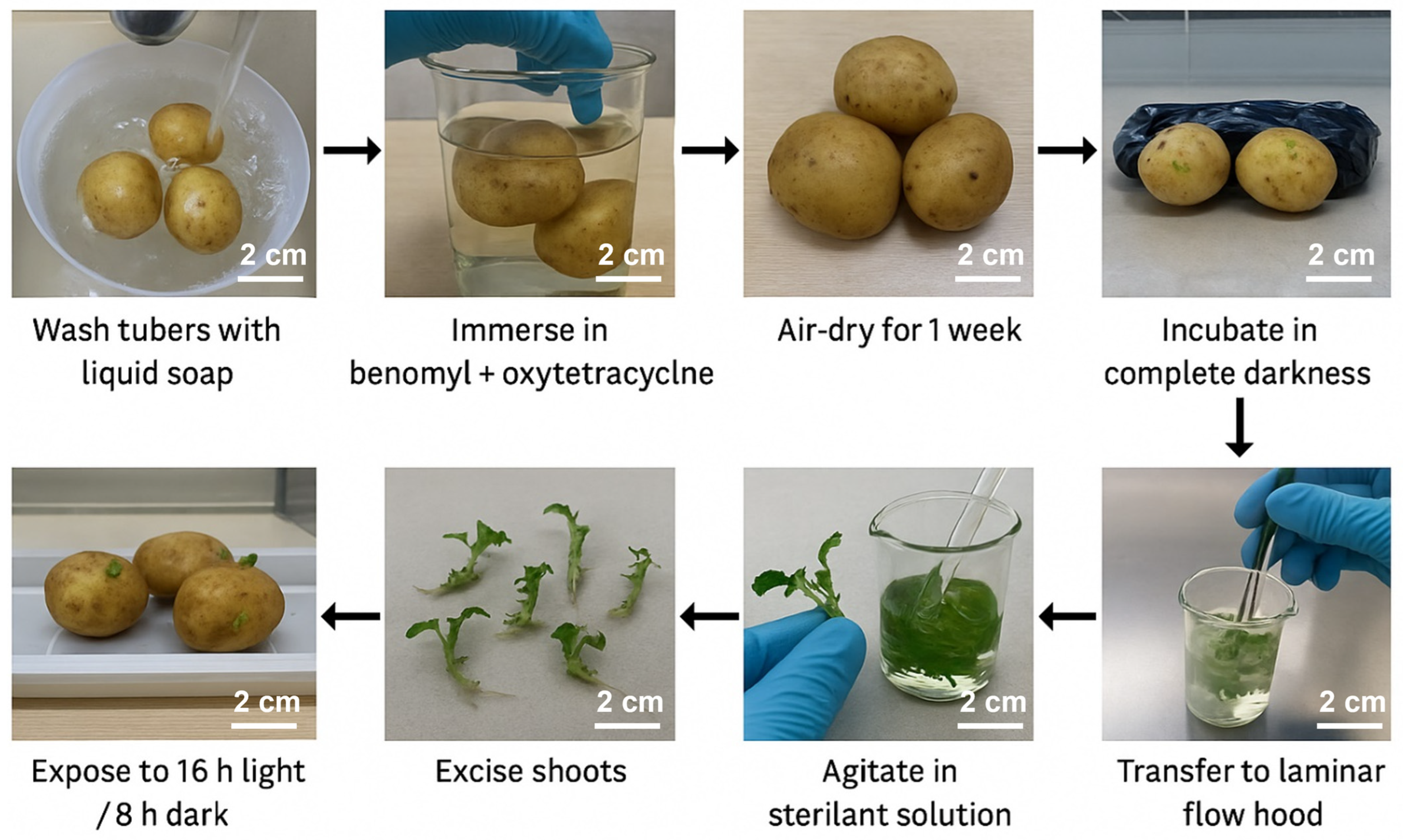
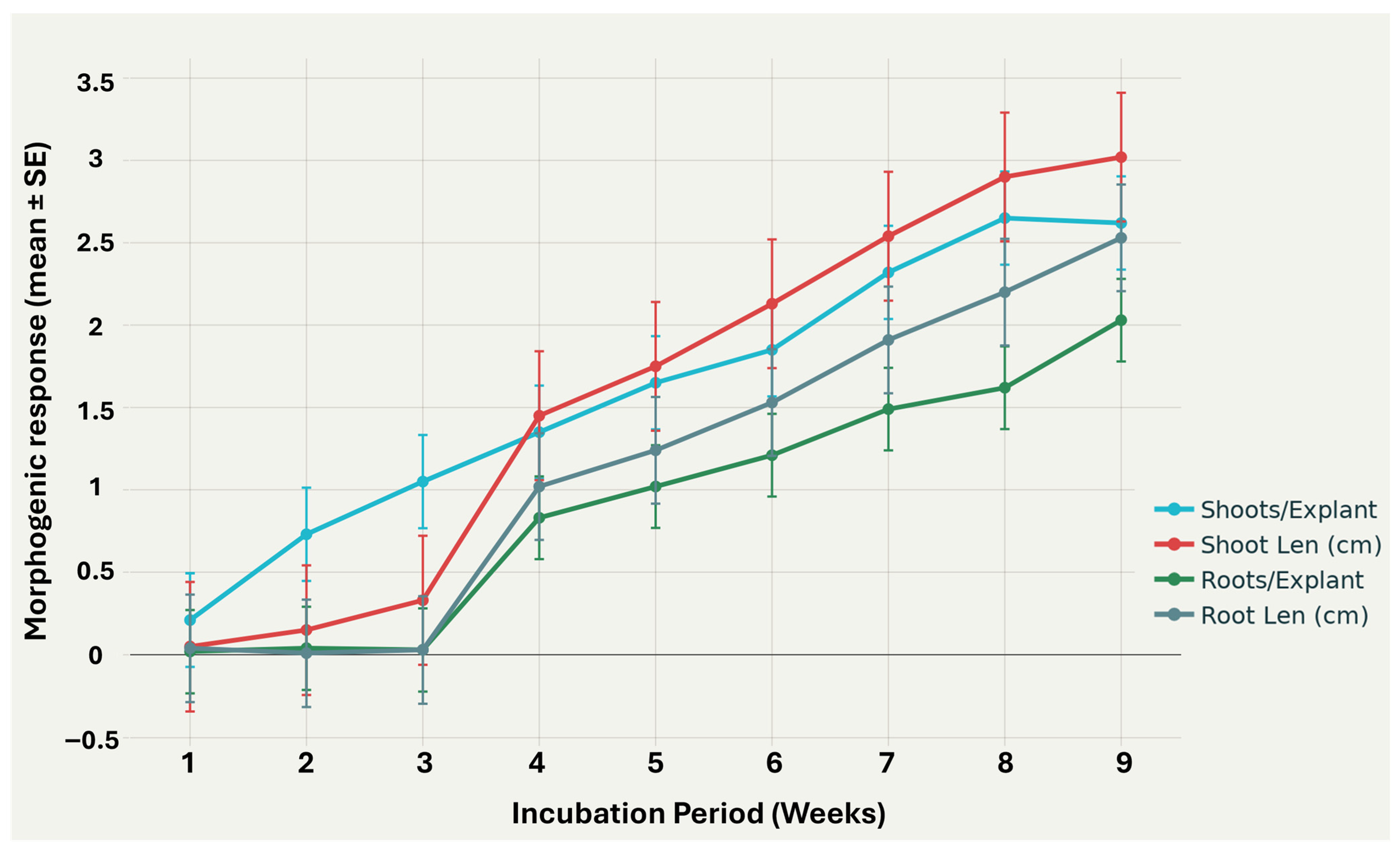
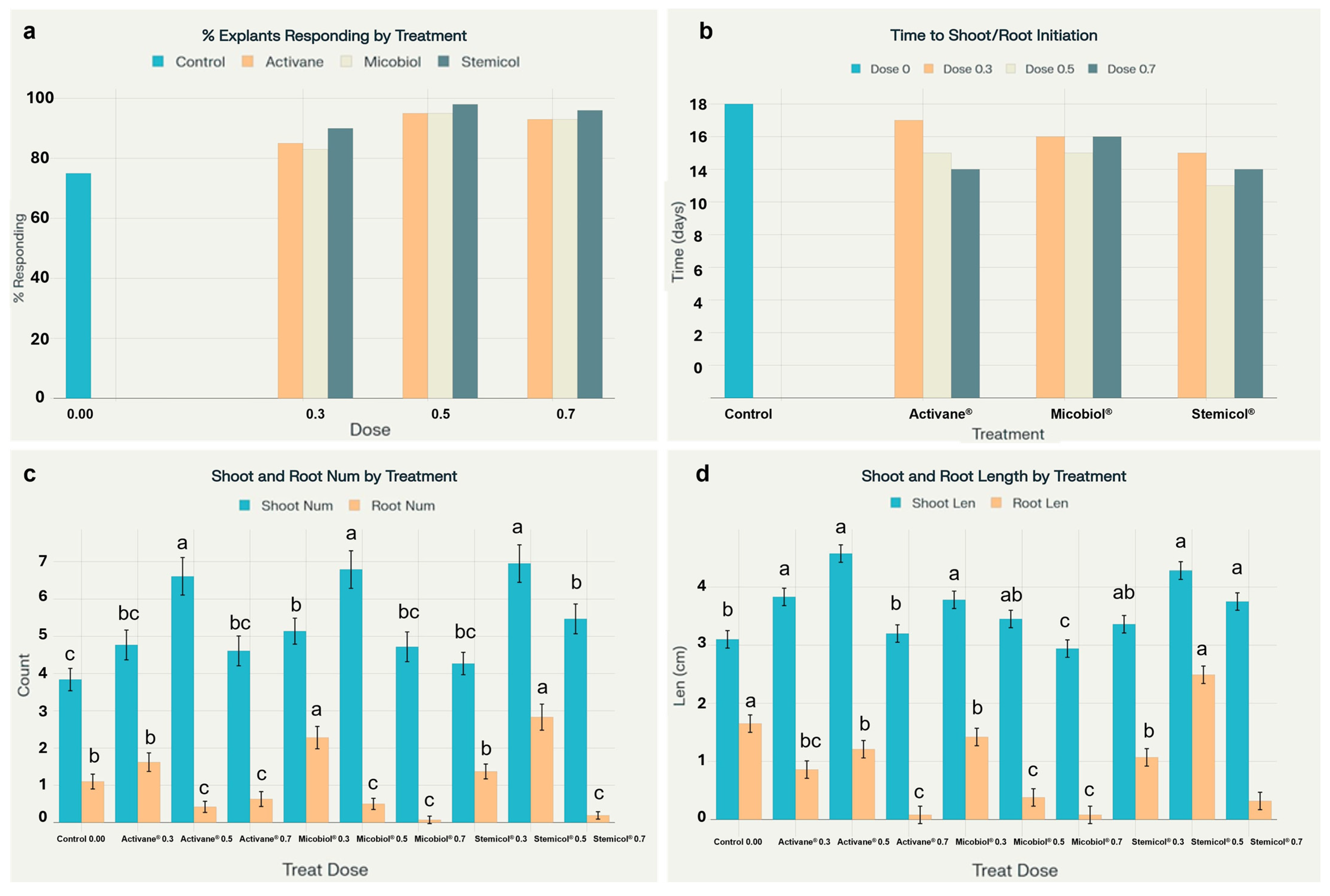
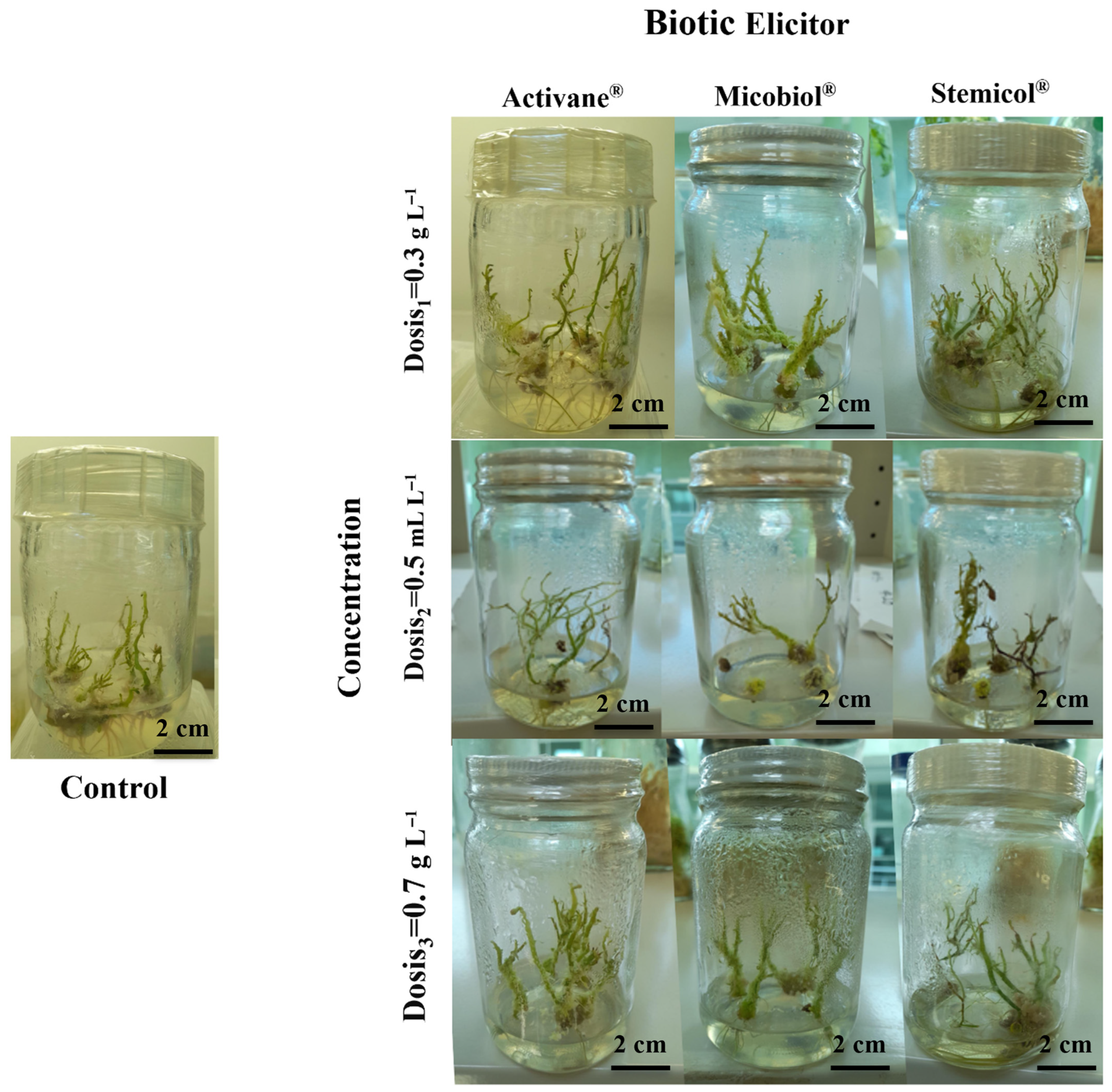
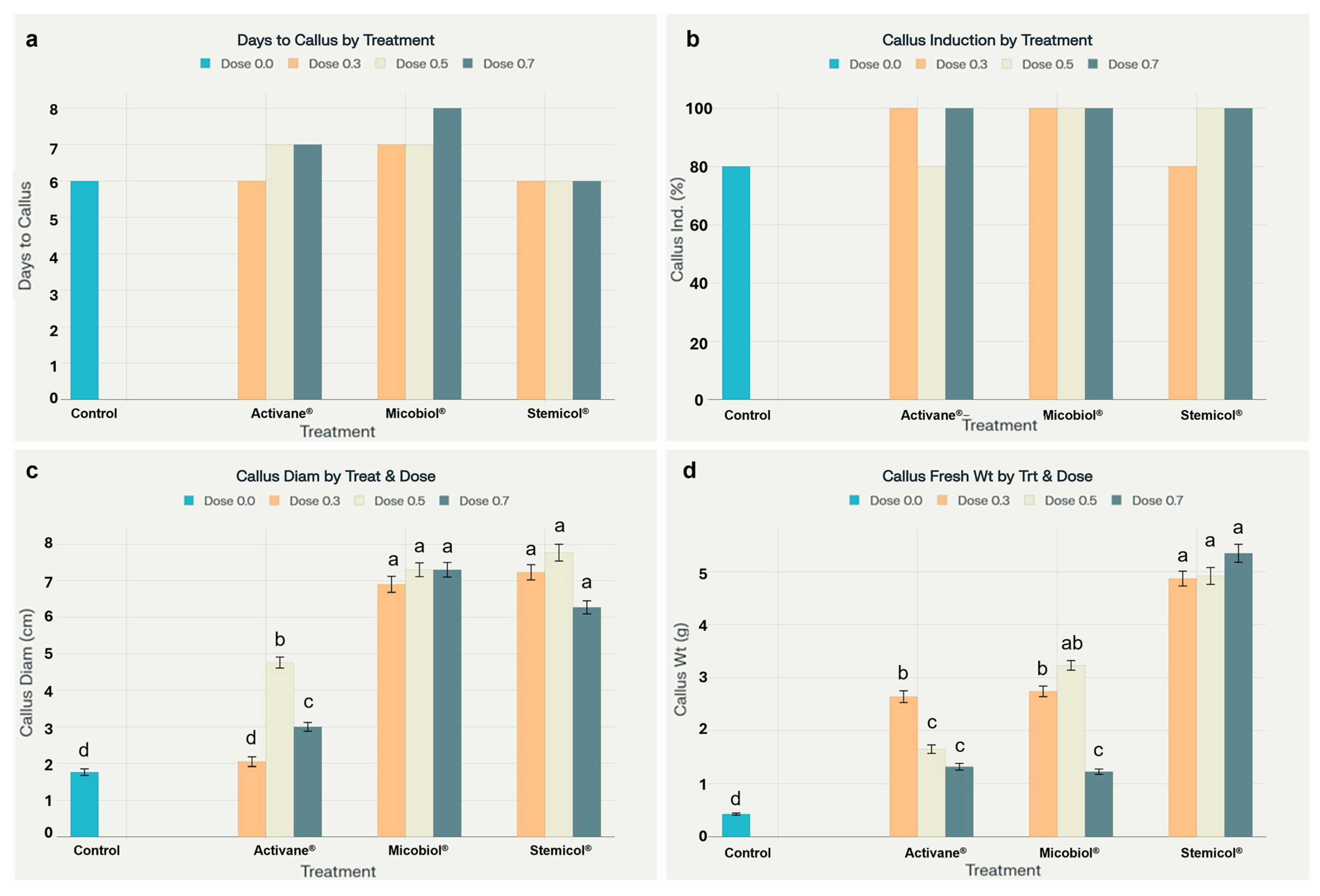
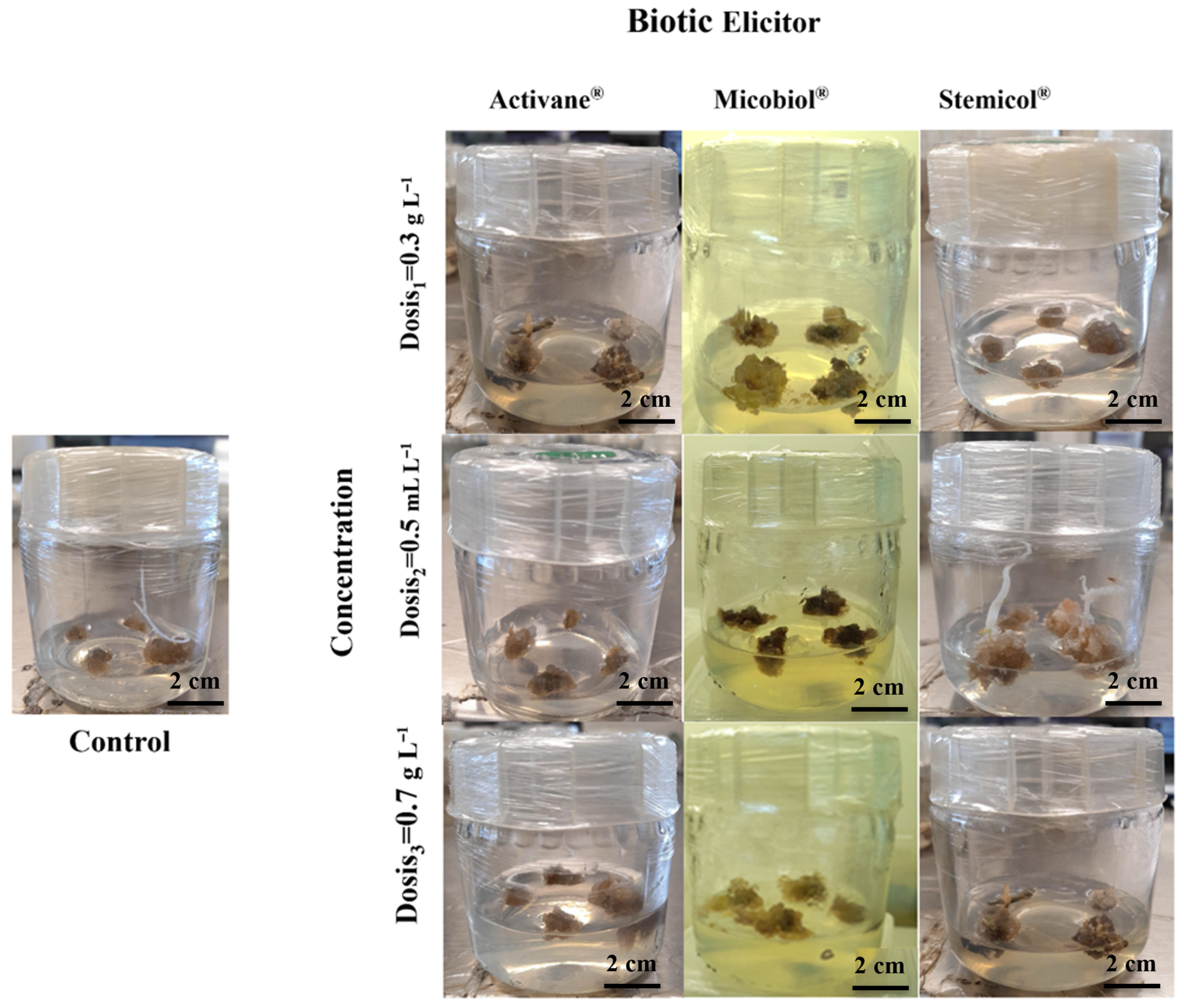
| Treatment | Hormone | Shoot Number | Shoot Length (cm) | Root Number | Root Length (cm) | Internode |
|---|---|---|---|---|---|---|
| T1: | Control (0.0) | 5.00 b | 4.45 b | 5.10 b | 4.20 b | 6.58 a |
| T2: | 0.2 NAA + 0.5 BAP | 6.95 a | 6.98 a | 6.10 a | 5.21 a | 5.48 ab |
| T3: | 0.2 NAA + 1.0 BAP | 6.16 a | 6.90 a | 6.10 a | 5.15 a | 5.16 ab |
| T4: | 0.2 NAA + 1.5 BAP | 4.86 c | 4.73 b | 5.20 b | 5.31 a | 4.58 c |
Disclaimer/Publisher’s Note: The statements, opinions and data contained in all publications are solely those of the individual author(s) and contributor(s) and not of MDPI and/or the editor(s). MDPI and/or the editor(s) disclaim responsibility for any injury to people or property resulting from any ideas, methods, instructions or products referred to in the content. |
© 2025 by the authors. Licensee MDPI, Basel, Switzerland. This article is an open access article distributed under the terms and conditions of the Creative Commons Attribution (CC BY) license (https://creativecommons.org/licenses/by/4.0/).
Share and Cite
James-Forest, M.; Ojeda-Zacarías, M.d.C.; Cham, A.K.; Lozoya-Saldaña, H.; Vázquez-Alvarado, R.E.; Olivares-Sáenz, E.; Ibarra-López, A. Biotic Elicitor-Driven Enhancement of In Vitro Micropropagation and Organogenesis in Solanum tuberosum L. cv. Fianna. BioTech 2025, 14, 77. https://doi.org/10.3390/biotech14040077
James-Forest M, Ojeda-Zacarías MdC, Cham AK, Lozoya-Saldaña H, Vázquez-Alvarado RE, Olivares-Sáenz E, Ibarra-López A. Biotic Elicitor-Driven Enhancement of In Vitro Micropropagation and Organogenesis in Solanum tuberosum L. cv. Fianna. BioTech. 2025; 14(4):77. https://doi.org/10.3390/biotech14040077
Chicago/Turabian StyleJames-Forest, Mario, Ma del Carmen Ojeda-Zacarías, Alhagie K. Cham, Héctor Lozoya-Saldaña, Rigoberto E. Vázquez-Alvarado, Emilio Olivares-Sáenz, and Alejandro Ibarra-López. 2025. "Biotic Elicitor-Driven Enhancement of In Vitro Micropropagation and Organogenesis in Solanum tuberosum L. cv. Fianna" BioTech 14, no. 4: 77. https://doi.org/10.3390/biotech14040077
APA StyleJames-Forest, M., Ojeda-Zacarías, M. d. C., Cham, A. K., Lozoya-Saldaña, H., Vázquez-Alvarado, R. E., Olivares-Sáenz, E., & Ibarra-López, A. (2025). Biotic Elicitor-Driven Enhancement of In Vitro Micropropagation and Organogenesis in Solanum tuberosum L. cv. Fianna. BioTech, 14(4), 77. https://doi.org/10.3390/biotech14040077






